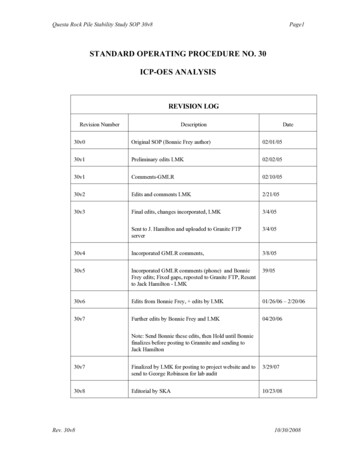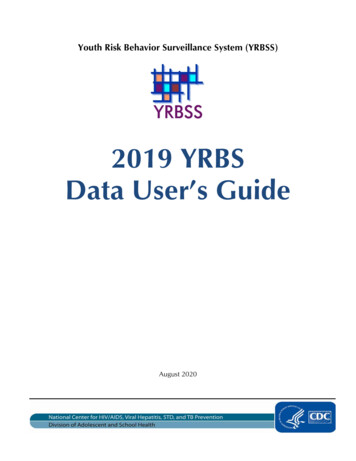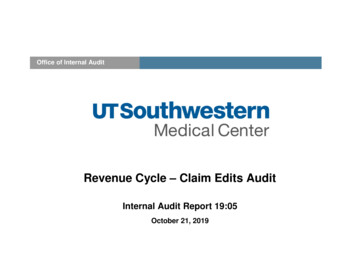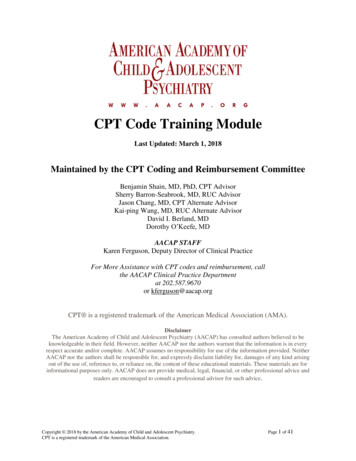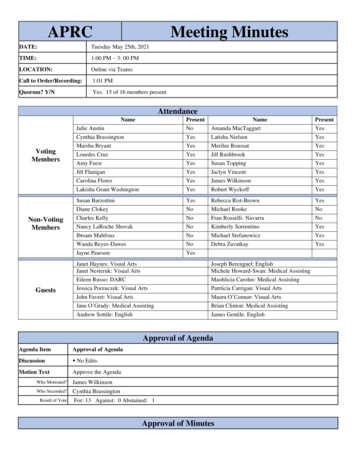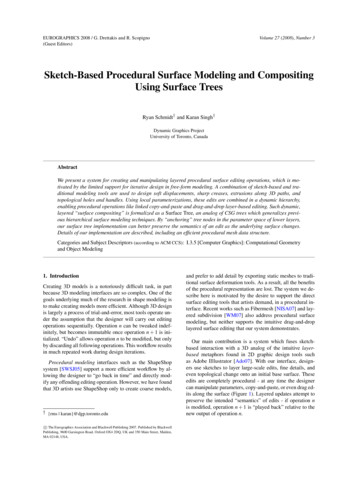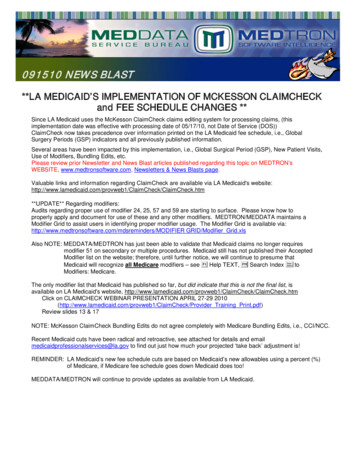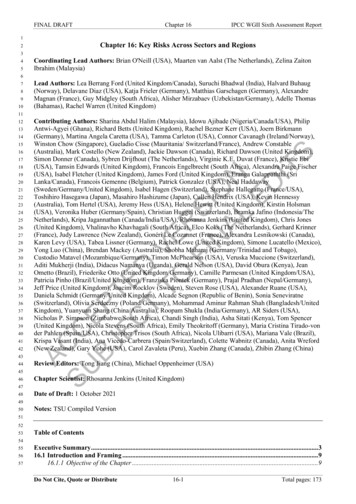
Transcription
FINAL DRAFTChapter 16IPCC WGII Sixth Assessment Report1Chapter 16: Key Risks Across Sectors and Regions2345Coordinating Lead Authors: Brian O'Neill (USA), Maarten van Aalst (The Netherlands), Zelina ZaitonIbrahim (Malaysia)678910Lead Authors: Lea Berrang Ford (United Kingdom/Canada), Suruchi Bhadwal (India), Halvard Buhaug(Norway), Delavane Diaz (USA), Katja Frieler (Germany), Matthias Garschagen (Germany), AlexandreMagnan (France), Guy Midgley (South Africa), Alisher Mirzabaev (Uzbekistan/Germany), Adelle Thomas(Bahamas), Rachel Warren (United 33343536373839404142434445464748Contributing Authors: Sharina Abdul Halim (Malaysia), Idowu Ajibade (Nigeria/Canada/USA), PhilipAntwi-Agyei (Ghana), Richard Betts (United Kingdom), Rachel Bezner Kerr (USA), Joern Birkmann(Germany), Martina Angela Caretta (USA), Tamma Carleton (USA), Connor Cavanagh (Ireland/Norway),Winston Chow (Singapore), Gueladio Cisse (Mauritania/ Switzerland/France), Andrew Constable(Australia), Mark Costello (New Zealand), Jackie Dawson (Canada), Richard Dawson (United Kingdom),Simon Donner (Canada), Sybren Drijfhout (The Netherlands), Virginie K.E. Duvat (France), Kristie Ebi(USA), Tamsin Edwards (United Kingdom), Francois Engelbrecht (South Africa), Alexandra Paige Fischer(USA), Isabel Fletcher (United Kingdom), James Ford (United Kingdom), Eranga Galappaththi (SriLanka/Canada), Francois Gemenne (Belgium), Patrick Gonzalez (USA), Neal Haddaway(Sweden/Germany/United Kingdom), Isabel Hagen (Switzerland), Stephane Hallegatte (France/USA),Toshihiro Hasegawa (Japan), Masahiro Hashizume (Japan), Cullen Hendrix (USA), Kevin Hennessy(Australia), Tom Hertel (USA), Jeremy Hess (USA), Helene Hewitt (United Kingdom), Kirstin Holsman(USA), Veronika Huber (Germany/Spain), Christian Huggel (Switzerland), Bramka Jafino (Indonesia/TheNetherlands), Kripa Jagannathan (Canada/India/USA), Rhosanna Jenkins (United Kingdom), Chris Jones(United Kingdom), Vhalinavho Khavhagali (South Africa), Elco Koks (The Netherlands), Gerhard Krinner(France), Judy Lawrence (New Zealand), Gonéri Le Cozannet (France), Alexandra Lesnikowski (Canada),Karen Levy (USA), Tabea Lissner (Germany), Rachel Lowe (United Kingdom), Simone Lucatello (Mexico),Yong Luo (China), Brendan Mackey (Australia), Shobha Maharaj (Germany/Trinidad and Tobago),Custodio Matavel (Mozambique/Germany), Timon McPhearson (USA), Veruska Muccione (Switzerland),Aditi Mukherji (India), Didacus Namanya (Uganda), Gerald Nelson (USA), David Obura (Kenya), JeanOmetto (Brazil), Friederike Otto (United Kingdom/Germany), Camille Parmesan (United Kingdom/USA),Patricia Pinho (Brazil/United Kingdom), Franziska Piontek (Germany), Prajal Pradhan (Nepal/Germany),Jeff Price (United Kingdom), Joacim Rocklov (Sweden), Steven Rose (USA), Alexander Ruane (USA),Daniela Schmidt (Germany/United Kingdom), Alcade Segnon (Republic of Benin), Sonia Seneviratne(Switzerland), Olivia Serdeczny (Poland/Germany), Mohammad Aminur Rahman Shah (Bangladesh/UnitedKingdom), Yuanyuan Shang (China/Australia), Roopam Shukla (India/Germany), AR Siders (USA),Nicholas P. Simpson (Zimbabwe/South Africa), Chandi Singh (India), Asha Sitati (Kenya), Tom Spencer(United Kingdom), Nicola Stevens (South Africa), Emily Theokritoff (Germany), Maria Cristina Tirado-vonder Pahlen (Spain/USA), Christopher Trisos (South Africa), Nicola Ulibarri (USA), Mariana Vale (Brazil),Krispa Vasant (India), Ana Vicedo-Carbrera (Spain/Switzerland), Colette Wabnitz (Canada), Anita Wreford(New Zealand), Gary Yohe (USA), Carol Zavaleta (Peru), Xuebin Zhang (Canada), Zhibin Zhang (China)ACSU CEBJ PEC TET DVTO ERFI SN IOAL NEDITS12Review Editors: Tong Jiang (China), Michael Oppenheimer (USA)Chapter Scientist: Rhosanna Jenkins (United Kingdom)Date of Draft: 1 October 20214950Notes: TSU Compiled Version515253Table of Contents54555657Executive Summary .316.1 Introduction and Framing .916.1.1 Objective of the Chapter .9Do Not Cite, Quote or Distribute16-1Total pages: 173
FINAL 829303132333435363738394041IPCC WGII Sixth Assessment Report16.1.2 Risk Framing .916.1.3 Storyline of the Chapter, and What’s New Compared to Previous Assessments.1016.1.4 Drivers of Exposure and Vulnerability .1316.2 Synthesis of Observed Impacts.1416.2.1 Definitions .1516.2.2 Methods and Data for Impact Attribution Including Recent Advances . 1616.2.3 Observed Impacts .1716.3 Synthesis of Observed Adaptation-related Responses .2516.3.1 Adaptation-related Responses by Natural Systems .2616.3.2 Adaptation-related Responses by Human Systems .2716.3.3 Knowledge Gaps in Observed Responses .39Cross-Chapter Box INTEREG: Inter-regional Flows of Risks and Responses to Risk .3916.4 Synthesis of Limits to Adaptation Across Natural and Human Systems .4416.4.1 Definitions and Conceptual Advances Since AR5.44Box 16.1: Linking Adaptation Constraints, Soft and Hard Limits .4516.4.2 Insights from Regions and Sectors about Limits to Adaptation .4616.4.3 Regional and Sectoral Synthesis of Limits to Adaptation .4816.5 Key Risks Across Sectors and Regions .5516.5.1 Defining Key Risks .5616.5.2 Identification and Assessment of Key Risks and Representative Key Risks .5716.5.3 Variation of Key Risks Across Levels of Global Warming, Exposure and Vulnerability, andAdaptation .7516.5.4 RKR Interactions .8016.6 Reasons for Concern Across Scales .8916.6.1 Key Risks and Sustainable Development .8916.6.2 Framework and Approach for Assessment of RFCs and Relation to RKRs .9316.6.3 Global Reasons for Concern .98Cross-Working Group Box ECONOMIC: Estimating Global Economic Impacts from Climate Change.11116.6.4 Summary.119FAQ16.1: What are key risks in relation to climate change? .121FAQ16.2 How does adaptation help to manage key risks and what are its limits?.122FAQ16.3: How do climate scientists differentiate between impacts of climate change and changes innatural or human systems that occur for other reasons? .123FAQ16.4: What adaptation-related responses to climate change have already been observed, and dothey help reduce climate risk? .124FAQ16.5: How does climate risk vary with temperature? .125FAQ16.6: What is the role of extreme weather events in the risks we face from climate change? .126References.128ACSU CEBJ PEC TET DVTO ERFI SN IOAL NEDITS1Chapter 16Do Not Cite, Quote or Distribute16-2Total pages: 173
FINAL DRAFT1Chapter 16IPCC WGII Sixth Assessment ReportExecutive Summary23Introduction and framing456789This chapter synthesizes observed climate change impacts (16.2), adaptation-related responses (16.3), limitsto adaptation (16.4), and the key risks identified across sectors and regions (16.5). We consider how theserisks accrue with increasing global average temperature; how they depend on future development andadaptation efforts; and what this implies for the Sustainable Development Goals and the five main Reasonsfor Concern about climate change (16.6).1011Observed 4353637383940414243444546474849505152The impacts of changes in climate-related systems have been identified in a wide range of natural,human, and managed systems (very high confidence1). Compared to the last IPCC AR5 there is moreevidence for impacts of long-term changes in climate-related systems (including the atmosphere, ocean andcryosphere) on socio-economic indicators and high confidence in the sensitivity of societies to weatherconditions. There is also stronger evidence for impacts of long-term climate change on ecosystems, includingthe observed widespread mortality of warm water corals, far reaching shifts in phenology in marine andterrestrial ecosystems and the expansion of tropical species into the ranges of temperate species, and borealspecies moving into Arctic regions (high confidence). {16.2.3, 16.2.3.1}ACSU CEBJ PEC TET DVTO ERFI SN IOAL NEDITS13Increased rainfall intensity associated with tropical cyclones and rising sea levels have contributed toobserved damages in local coastal systems (medium confidence). However, while the impact is expectedto be widespread, formal attribution of damages to long term changes in the climate-related systems is stilllimited by restricted knowledge about changes in exposure and vulnerability and the missing quantificationof the contribution of sea level rise to the extent of flooded areas. {16.2.3.3}Due to complex interactions with socio-economic conditions, evidence on the impact of long-termclimate change on crop prices and malnutrition is largely lacking while the sensitivity of malnutrition toweather conditions has become more evident in some regions, particularly Africa (medium to highconfidence). A negative impact of long-term climate change on crop yields has been identified in someregions (e.g., wheat yields in Europe) (medium confidence) while studies are still inconsistent in otherregions. {16.2.3.4}Climate change has increased observed heat-related mortality (medium confidence) and contributed tothe observed latitudinal or altitudinal range expansion of vector- borne diseases into previously colderareas (medium to high confidence) while evidence on the impact of long-term climate change on waterborne diseases is largely lacking. Overall, there is extensive observational evidence that extreme ambienttemperatures increase human mortality (high confidence) and that the occurrence of water- and vector-bornediseases is sensitive to weather conditions (high confidence). {16.2.3.5, 16.2.3.6, 16.2.3.7}Extreme weather events not only cause substantial direct economic damage (high confidence), but alsoreduce economic growth in the short-term (year of, and year after event) (high confidence) as well asin the long-term (up to 15 years after the event) (medium confidence), with more severe impacts indeveloping than in industrialized economies (high confidence). Evidence has increased for all of theseconclusions; however, evidence for impacts of long-term climate change is still limited. {16.2.3.7}Climate variability and extremes are associated with increased prevalence of conflict, with moreconsistent evidence for low-intensity organized violence than for major armed conflict (mediumconfidence). Compared to other socio-economic drivers, the link is relatively weak (medium confidence) andconditional on high population size, low socioeconomic development, high political marginalization, andhigh agricultural dependence (medium confidence). Literature also suggests a larger climate-related influence1In this Report, the following summary terms are used to describe the available evidence: limited, medium, or robust;and for the degree of agreement: low, medium, or high. A level of confidence is expressed using five qualifiers: verylow, low, medium, high, and very high, and typeset in italics, e.g., medium confidence. For a given evidence andagreement statement, different confidence levels can be assigned, but increasing levels of evidence and degrees ofagreement are correlated with increasing confidence.Do Not Cite, Quote or Distribute16-3Total pages: 173
FINAL DRAFT12Chapter 16IPCC WGII Sixth Assessment Reporton the dynamics of conflict than on the likelihood of initial conflict outbreak (low confidence). There isinsufficient evidence at present to attribute armed conflict to climate change. {16.2.3.8}3456789101112There is high confidence that anthropogenic climate forcing has had an impact on internaldisplacement, given the observed impact of anthropogenic climate forcing on the occurrence ofweather extremes (high confidence, Table SM16.21) and the strong contribution of weather extremesto observed displacement (high confidence). However, the link between long-term changes in the climaterelated systems has not been demonstrated systematically and so far there is no attribution of observed trendsin displacement to long-term changes in the climate-related systems. Links between weather fluctuations(including extreme events) and human mobility are complex and conditional on socio-economic situations;e.g., poor populations may more often be involuntarily displaced or ‘trapped’ and not be able to migrate.{16.2.3.9}1314Observed adaptation in 363738394041424344454647While species are increasingly responding to climate change, these responses may not be adaptive orsufficient to cope with the rate of climate changes (high confidence). Responses have been documented ina range of species, including for example changes in the timing of breeding and migration. It is unclearwhether these responses reflect long-term evolutionary adaptation or short-term coping mechanisms.Existing assessments indicate that some species’ responses will be insufficient to avert extinction. {16.3.1}ACSU CEBJ PEC TET DVTO ERFI SN IOAL NEDITS16Observed adaptation-related responses in human systemsResponses across all sectors and regions reported in the scientific literature are dominated by minormodifications to usual practices or measures for dealing with extreme weather events, whilst evidenceof transformative adaptation in human systems is low (high confidence). Responses have accelerated inboth developed and developing regions since AR5, with some examples of regression. Despite this, there isnegligible evidence in the scientific literature documenting responses that are simultaneously widespread,rapid, and that challenge norms and adaptation limits. {16.3.2.3}There is negligible evidence that existing responses are adequate to reduce climate risk (highconfidence). There is some evidence of global vulnerability reduction, particularly for mortality andeconomic losses due to flood risk and extreme heat. (16.3.2.4) Evidence on the effectiveness of specificadaptations remains limited. There is negligible robust evidence to assess the overall adequacy of the globaladaptation response to address the scale of climate risk. No studies have systematically assessed theadequacy and effectiveness of adaptation at a global scale, across nations or sectors, or for different levels ofwarming. {16.3.2.3}Adaptation responses are showing co-benefits, for mitigation and other societal goals (highconfidence). There is increasing evidence of co-benefits of adaptation responses. Co-benefits are mostfrequently linked to changes in agricultural practices (e.g., conservation agriculture), land use management(e.g., agroforestry), building technologies (e.g., building efficiency standards), and urban design (e.g.,walkable neighbourhoods). {16.3.2.3}Evidence of maladaptation is increasing (high confidence), i.e. adaptation that increases climate risk orcreates new risks in other systems or for other actors. Globally, maladaptation has been reported mostfrequently in the context of agriculture and migration in the global south. {16.3.2.6}4849Limits to adaptation across natural and human systems50515253545556There is increasing evidence on limits to adaptation which result from the interaction of adaptationconstraints and can be differentiated into soft and hard limits (high confidence). Soft limits may changeover time as additional adaptation options become available. Hard limits will not change over time as noadditional adaptive actions are possible. Evidence focuses on constraints that may lead to limits at somepoint of the adaptation process, with less information on how limits may be related to different levels ofsocio-economic or climatic change (high confidence). {16.4.1, 16.4.2, 16.4.3}57Do Not Cite, Quote or Distribute16-4Total pages: 173
FINAL DRAFT12345678910Chapter 16IPCC WGII Sixth Assessment ReportLimits to adaptation have been identified for terrestrial and aquatic species and ecosystems, coastalcommunities, water security, agricultural production, and human health and heat (high confidence).Beginning at 1.5 C, autonomous and evolutionary adaptation responses by terrestrial and aquatic species andecosystems face hard limits, resulting in biodiversity decline, species extinction and loss of relatedlivelihoods (high confidence). Beginning at 3 C, hard limits are projected for water management measures,leading to decreased water quality and availability, negative impacts on health and wellbeing, economiclosses in water and energy dependent sectors and potential migration of communities (medium confidence).Adaptation to address risks of heat stress, heat mortality and reduced capacities for outdoor work for humansface soft and hard limits across regions beginning at 1.5 C, and are particularly relevant for regions withwarm climates (high confidence). {16.4.2, 33435363738394041424344454647484950515253Soft limits are currently being experienced by individuals and households along the coast and bysmall-scale farmers (medium confidence). As sea levels rise and extreme events intensify, coastalcommunities face soft limits due to financial, institutional and socio-economic constraints reducing theefficacy of coastal protection and accommodation approaches and resulting in loss of life and economicdamages (medium confidence). {16.4.2, 16.4.3}ACSU CEBJ PEC TET DVTO ERFI SN IOAL NEDITS12Hard limits for coastal communities reliant on nature-based coastal protection will be experiencedbeginning at 1.5 C (medium confidence). Soft and hard limits for agricultural production are related towater availability and the uptake and effectiveness of climate-resilient crops which are constrained by socioeconomic and political challenges (medium confidence). {16.4.2, 16.4.3}Across regions and sectors, the most significant determinants of soft limits are financial, governance,institutional and policy constraints (high confidence). The ability of actors to overcome these socioeconomic constraints largely influence whether additional adaptation is able to be implemented and preventsoft limits from becoming hard. While the rate, extent and timing of climate hazards largely determine hardlimits of biophysical systems, these factors appear to be less influential in determining soft limits for humansystems (medium confidence). {16.4.2, 16.4.3}Financial constraints are important determinants of limits to adaptation, particularly in low-to-middleincome countries (high confidence). Impacts of climate change may increase financial constraints (highconfidence) and contribute to soft limits to adaptation being reached (medium confidence). Global andregional evidence shows that climate impacts may limit the availability of financial resources, stunt nationaleconomic growth, result in higher levels of losses and damages and thereby increase financial constraints.{16.4.3.2, 16.4.3.3}Key risks across climate and development pathwaysRegional and sectoral chapters of this report identified over 130 Key Risks (KRs) that could becomesevere under particular conditions of climate hazards, exposure, and vulnerability. These key risk arerepresented in eight so-called Representative Key Risks (RKRs) clusters of key risks relating to lowlying coastal systems; terrestrial and ocean ecosystems; critical physical infrastructure, networks andservices; living standards; human health; food security; water security; and peace and mobility (highconfidence). A key risk is defined as a potentially ‘severe’ risk, i.e. that is relevant to the interpretation ofdangerous anthropogenic interference (DAI) with the climate system. Key risks cover scales from the localto the global, are especially prominent in particular regions or systems, and are particularly large forvulnerable subgroups, especially low-income populations, and already at-risk ecosystems (high confidence).The conditions under which RKRs would become severe have been assessed along levels for warming,exposure/vulnerability, and adaptation: for warming, high refers to climate outcomes consistent with RCP8.5or higher, low refers to climate outcomes consistent with RCP2.6 or lower, and medium refers tointermediary climate scenarios; exposure/vulnerability levels are relative to the range of future conditionsconsidered in the literature; for adaptation, high refers to near maximum potential and low refers to thecontinuation of today’s trends. (6.5.2.1, 16.5.2.2, Table SM16.4).54555657For most Representative Key Risks (RKRs), potentially global and systemically pervasive risksbecome severe in the case of high warming, combined with high exposure/vulnerability, lowadaptation, or both (high confidence). Under these conditions there would be severe and pervasive risks toDo Not Cite, Quote or Distribute16-5Total pages: 173
FINAL DRAFT12345678910Chapter 16IPCC WGII Sixth Assessment Reportcritical infrastructure and to human health from heat-related mortality (high confidence), to low-lying coastalareas, aggregate economic output, and livelihoods (all medium confidence), of armed conflict (lowconfidence), and to various aspects of food security (with different levels of confidence). Severe risksinteract through cascading effects, potentially causing amplification of RKRs over the course of this century(low evidence, high agreement). {16.5.2.3, 16.5.2.4, 16.5.4, Figure 16.10}For some RKRs, potentially global and systemically pervasive risks would become severe even withmedium to low warming (i.e. 1.5-2 C) if exposure/vulnerability is high and/or adaptation is low(medium to high confidence). Under these conditions there would be severe and pervasive risks associatedwith water scarcity and water-related disasters (high confidence), poverty, involuntary mobility, and insularecosystems and biodiversity hotspots (all medium confidence). {16.5.2.3, 233343536373839404142434445464748All potentially severe risks that apply to particular sectors or groups of people at more specificregional and local levels require high exposure/vulnerability or low adaptation (or both), but do notnecessarily require high warming (high confidence). Under these conditions there would be severe,specific risks to low-lying coastal systems, to people and economies from critical infrastructure disruption,economic output in developing countries, livelihoods in climate-sensitive sectors, waterborne diseasesespecially in children in low- and middle-income countries, water-related impacts on traditional ways of life,and involuntary mobility for example in small islands and low-lying coastal areas (medium to highconfidence). {16.5.2.3, 16.5.2.4}ACSU CEBJ PEC TET DVTO ERFI SN IOAL NEDITS12Some severe impacts are already occurring (high confidence) and will occur in many more systemsbefore mid-century (medium confidence). Tropical and polar low-lying coastal human communities areexperiencing severe impacts today (high confidence), and abrupt ecological changes resulting from masspopulation-level mortality are already observed following climate extreme events. Some systems willexperience severe risks before the end of the century (medium confidence), for example critical infrastructureaffected by extreme events (medium confidence). Food security for millions of people, particularly lowincome populations, also faces significant risks with moderate to high warming or high vulnerability, with agrowing challenge by 2050 in terms of providing nutritious and affordable diets (high confidence). {16.5.2.3,16.5.3}In specific systems already marked by high exposure and vulnerability, high adaptation efforts willnot be sufficient to prevent severe risks from occurring under high warming (low evidence, mediumagreement). This is particularly the case for some ecosystems and water-related risks (from water scarcityand to indigenous and traditional cultures and ways of life). {16.5.2.3, 16.5.2.4, 16.5.3}Interconnectedness and globalization establish pathways for the transmission of climate-related risksacross sectors and borders, for instance through trade, finance, food, and ecosystems (highconfidence). Examples include semiconductors, global investments, major food crops like wheat, maize andsoybean, and transboundary fish stocks. There are knowledge gaps on the need for, effectiveness of, andlimits to adaptation to such interregional risks {Cross-Chapter Box INTERREG in this Chapter}Key risks increase the challenges in achieving global sustainability goals (high confidence). The greatestchallenges will be from risks to water (RKR-G), living standards (RKR-D), coastal socio-ecological systems(RKR-A) and peace and human mobility (RKR-H). The most relevant goals are Zero hunger (SDG2),Sustainable cities and communities (SDG11), Life below water (SDG14), Decent work and economicgrowth (SDG8), and No poverty (SDG1). Priority areas for regions are indicated by the intersection ofhazards, risks and challenges, where, in the near term, challenges to SDGs indicate probable systemicvulnerabilities and issues in responding to climatic hazards. (high confidence) {16.6.1}49505152The scale and nature of climate risks is partly determined by the responses to climate change, not only inhow they reduce risk, but also how they may create other risks (sometimes inadvertently, and sometimes toothers than those who implement the response, in other places, or later in time).5354555657Solar Radiation Modification (SRM) approaches have potential to offset warming and ameliorateother climate hazards, but their potential to reduce risk or introduce novel risks to people andecosystems is not well understood (high confidence). SRM effects on climate hazards are highly dependenton deployment scenarios and substantial residual climate change or overcompensating change would occurDo Not Cite, Quote or Distribute16-6Total pages: 173
FINAL DRAFT12345678910Chapter 16IPCC WGII Sixth Assessment Reportat regional scales and seasonal timescales (high confidence). Due in part to limited research, there is lowconfidence in projected benefits or risks to crop yields, economies, human health, or ecosystems. Largenegative impacts are projected from rapid warming for a sudden and sustained termination of SRM in a highCO2 scenario. SRM would not stop CO2 from increasing in the atmosphere or reduce resulting oceanacidification under continued anthropogenic emissions (high confidence). There is high agreement in theliterature that for addressing climate change risks SRM is, at best, a supplement to achieving sustained netzero or net negative CO2 emission levels globally. Co-evolution of SRM governance and research provides achance for responsibly developing SRM technologies with broader public participation and politicallegitimacy, guarding against potential risks and harms relevant across a full range of scenarios. [CrossWorking Group Box 3536373839404142434445464748Recent global est
FINAL DRAFT Chapter 16 IPCC WGII Sixth Assessment Report Do Not Cite, Quote or Distribute 16-4 Total pages: 173 1 on the dynamics of conflict than on the likelihood of initial conflict outbreak (low confidence).There is 2 insufficient evidence at present to attribute armed conflict to climate change. {16.2.3.8} 3 4 There is high confidence that anthropogenic climate forcing has had an impact .

